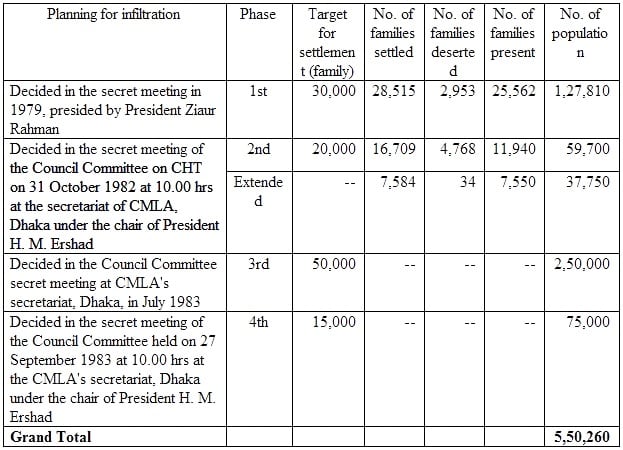Government-Sponsored Migration and Islamization in CHT
Introduction
Plight of indigenous peoples is marked with both common and uncommon features with regards to injustice done upon them by the ruling classes. In most cases, their territories are taken for exploration by relocating them to other places without obtaining their consent. In some cases, it is seen that the regimes become tyrants and adopt ethnic cleansing policy that leads to extinction of targeted human species. In this part of the globe, it was the successive rulers of Pakistan and by now, it is the successive governments of Bangladesh to carry out such heinous policy ever since it’s coming into being as a free nation. This has been being exercised by repelling the sections proving legal protection for the ethnic indigenous peoples from the law introduced by the British-India government in 1900.
CHT Regulation 1900: A safeguard to CHT Indigenous peoples
The CHT Regulation, 1900 (Regulation 1 of 1900) acted as a bulwark for more than a century against encroachment of lands by the Bengali Muslims in CHT. In fact, several provisions of CHT Regulation, 1900 functioned as a safeguard for the Jumma indigenous peoples from getting swallowed by the majority population. The Regulation was supplemented by the “Inner-line Act,” which was made annulled during Pakistan period. The laws prohibited land ownership and migration of outside peoples to CHT. In CHT Regulation 1900 (original) it was clearly stated that:
“No person other than a Chakma, Mogh or a member of any tribe indigenous of CHT, the Lushai Hills, the Arakan Hill Tracts or the State of Tripura shall enter or reside within CHT unless he is in possession of a permit granted by the Deputy Commissioner at his discretion.”
However, The Regulation has been weakened through bringing repeated amendments by the successive governments of Pakistan and Bangladesh to legalize infiltration and migration of non-indigenous people from plains. Section-34 dealing with land rights of the Jumma peoples has been under continuous onslaught of the government. Sections-51 and 52 dealing with expulsion of undesirable elements and prohibiting immigration into the CHT have been abolished. Land settlement to accommodate the Bengali settlers was completed under direct involvement by the Army, ignoring the traditional institutions and traditional customary land laws.
Settlement program during Pakistan Period:
It may be mentioned that despite of being a ‘Non-Muslim’ region by 98%, CHT was bartered and annexed to Pakistan in 1947 during partition. Pakistan government enacted the CHT (Land Acquisition) Regulation, 1958 and repelled several sections of the CHT Regulation 1900 that made CHT an “Excluded” area with strong prohibition of entrance of the outsiders into CHT including possession of lands within the territory of CHT. In 1960s, two major events directing to ethnic eradication took place in CHT. Firstly, construction of Hydro-electric Dam across the Karnaphuli River at Kaptai that opened up waterways up to the upper reaches of the rivers and their tributaries while uprooting one tenth million of indigenous peoples from their ancestral lands and homesteads. Secondly, Pakistan government shifted thousands of Muslim Bengali families into CHT from plain districts including thousands of Muslim Bengali people coming from India and settled them at Nakhyangchari and Lama of present Bandarban Hill District and at Naniarchar and Longadu of present Rangamati Hill District, the process of which continued up to 1996. Thus the first phase of ethnic cleansing policy ended in grand success.
Bangladesh Period: Sponsored Infiltration to Sponsored land occupation
‘Rules of the Bazaar Fund, 1937’ had been the only option for an outsider to obtain a permit to enter into CHT for business purpose by which trade and business could prosper during British period. The government of Pakistan made use of this legal provision to its optimum level. Immediately after independence, initially, it is the successive governments of Bangladesh to make use the legal provision to the extent as per whims and wishes without facing any abatement. People from plain district began to come to run business and would hold lands for residential use under patronization of the state machineries. With the opening of new business centers (bazaars) extending up to the rural areas using the waterways, infiltration of outsiders got multiplied rapidly.
Implementation of ‘Blue Print’ throughout CHT:
Now, it is the government to start ethnic cleansing program through land occupation by shifting thousands of plain dwellers into CHT in a phased manner, giving the lands in lease to the outside investors, acquisition of lands in the name of expansion of cantonment areas, establishment of stations for BGB forces and very recently, in the name of Tourism development and so on. General Ziaur Rahaman, the then Chief Martial Law Administrator (CMLA)-turned President, using both army, Para-military forces, state machineries and especially, the civilian people from plains set out with the mission: “Operation Dabanol” (Operation Wildfire). The northwest frontier of CHT i.e. the Feni River valley had been the first vulnerable target since 1972, to come under implementation process of the ‘blue print’ directly sponsored by the government. Some 100,000 Muslim settlers were settled under government patronization as of 1997. From 1976 to 1995, in principle, the army all through General Ziaur Rahaman, General H. M. Ershad and Begum Khaleda Zia, was in power covertly or overtly. Government comes and government goes but the policy towards CHT and its peoples is never to be changed. Unleashing planned communal attacks frequently by the Muslim settlers upon the targeted-dwellings of Jumma peoples with active support of army and Para-military combined forces is the ‘modus operendi’ of land occupation. The attacks are always associated with killing, looting, raping and arson that result in mass desertion of homesteads and lands by the Jumma peoples and followed by occupation of lands by the settlers immediately after abandonment. During this period, CHT witnesses at least 13 massacres. The successive governments with the state machineries and army have been operating the settlement program ever since.
Infiltration in CHT under government-sponsored transmigration programme

Number of Illegal Settlements
Total More than 400,000 Settlers in Three Phases with the direct backings of Government:
(a) 1st Phase (1978-1981) 30,740 Families/ around 140,000 Settlers
(b) 2nd Phase (1981-1982) 23,519 Families/ around 100,000 settlers
(c) 3rd Phase (1982-1984) More than 1,258 Families/ around 50,000 Settlers.
Areas where settled down
1st Phase (1978-1981):
(a) Tabulchari (1,810 Families),
(b) Ramgarh (3,589 Families),
(c) Kaukhali (2,792 Families),
(d) Lama (7,438 Families),
(e) Alikadam (750 Families),
(f) Vashanya Adam (1,408 Families),
(g) Longudu (8,225 Families),
(h) Bagachattar (2,772 Families),
(i) Nakhyangchari (1,956 Families)
(j) Total (30,740 Families)
2nd Phase (1981-1982):
(a) Panchari (2,375 Families),
(b) Ghuri Para (458 Families),
(c) Abhya (1,233 Families),
(d) Alutila (3,178 Families),
(e) Burighat (1,633 Families),
(f) Bhaibhonchara (4,18 Families),
(g) Bara Marung (2,220 Families),
(h) Adarakchara (2,078 Families),
(i) Kachalong (416 Families),
(j) Bhusanchara (1,705 Families),
(k) Shuvalong (518 Families),
(l) Koraichari (502 Families),
(m) Lakhsmichari (1,500 Families),
(n) Bangalhadiya (719 Families),
(o) Faitung (2,301 Families),
(p) Kamalchari (2,272 Families),
(q) Total (23,526 Families).
3rd Phase (1982-1984):
(a) Shindukchari (446 Families),
(b) Babuchara (812 Families)
(c) Total (1,258 Families)
Continuous process of infiltration/settlement:
As a continuous process of infiltration, the government of Bangladesh has settled down around 50,000 in 1984-1991 and around 10,000 in 1991 to 1996. Of course, this does not mean that the program has come to an end by now. In practice, it requires no special arrangements to bring the non-indigenous people into CHT from plains as it used to. At present the non-indigenous families are seen coming in batches at the wee hours only to get disappeared before the day breaks and after some days new settlements appear in some places. This process is seen active in the recent days. It is an interesting fact to note that the census report is not reflected with community-wise data and hence, it is hardly possible to figure out the exact numbers of non-indigenous peoples in contrast to the indigenous communities.

